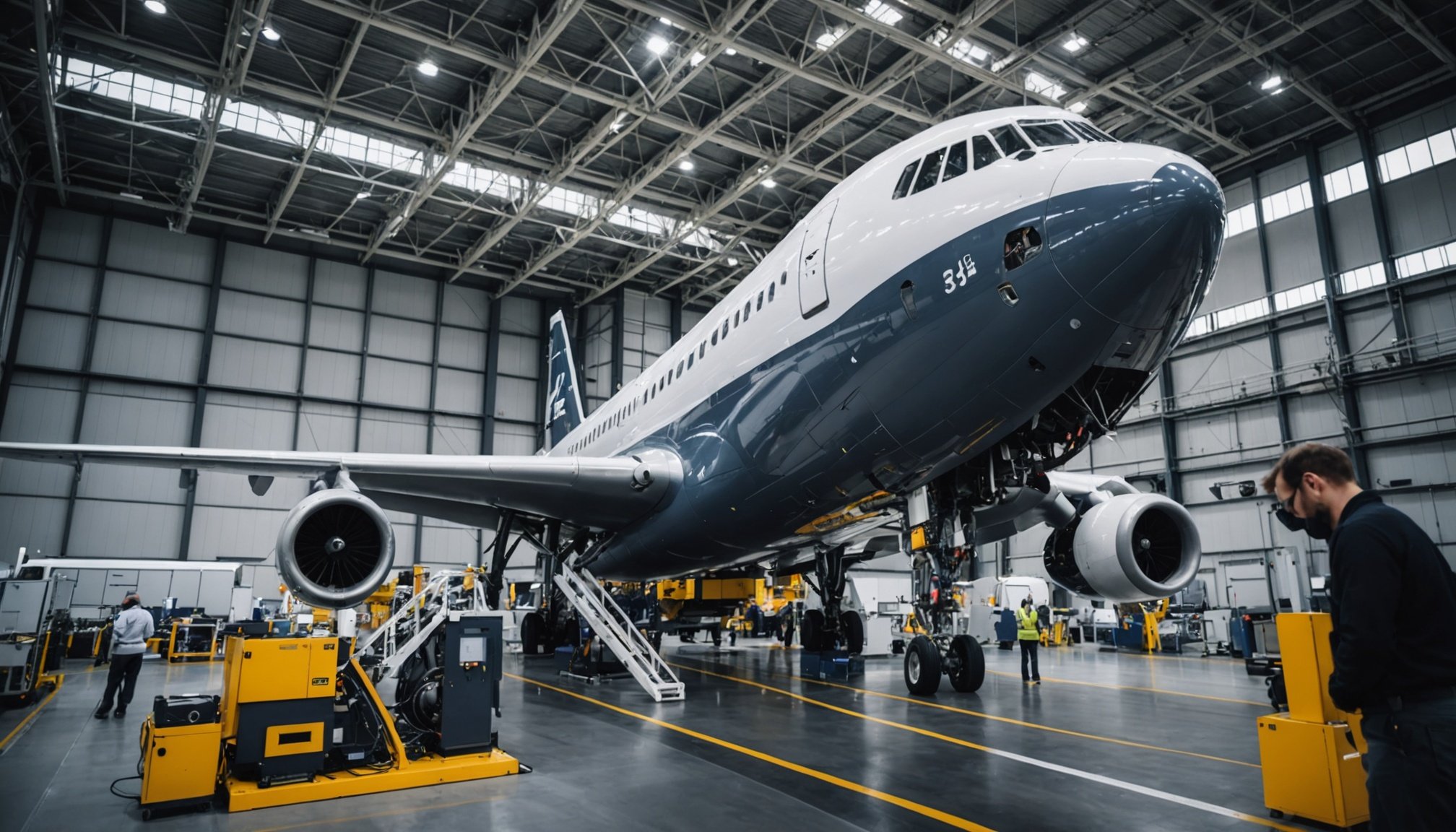Introduction to AI in Aerospace Engineering
Artificial Intelligence (AI) is transforming the field of aerospace engineering with its innovative applications and technologies. By leveraging AI, the industry has witnessed advancements in predictive maintenance and operational efficiency, which are critical for safe and cost-effective operations.
Predictive maintenance is a pivotal application of AI in aerospace. By utilizing machine learning algorithms, AI can analyze data and foresee potential mechanical failures, thus preventing unexpected downtimes. This not only improves safety but also enhances operational efficiency by scheduling timely maintenance, ensuring aircraft are operationally ready without unnecessary delays.
In the same genre : Revamping city travel: harnessing ai to optimize traffic management in urban transport systems
Moreover, current trends see AI becoming more sophisticated, enabling real-time monitoring and decision-making processes. The integration of AI allows for better data management and insightful analysis, optimizing flight paths, fuel consumption, and even improving customer services by predicting demands and preferences.
In aerospace engineering, AI is not just about flying aircraft; it’s about flying them smarter, safer, and more efficiently. As the industry continues to evolve, AI’s role will only become more central, shaping a future where AI aerospace engineering embodies cutting-edge innovation and reliability.
Topic to read : Enhancing data security: effective techniques for amplifying encryption in hybrid cloud environments
Applications of AI in Predictive Maintenance
Predictive maintenance utilises AI applications to enhance equipment reliability by anticipating failures before they occur. This innovative approach relies on predictive analytics, which leverages data to foresee equipment maintenance needs. Various AI algorithms are pivotal in this domain, including machine learning, which identifies patterns in data sets, enabling more accurate predictions. Integrating data analytics with IoT provides real-time monitoring capabilities, further refining prediction accuracy.
AI Algorithms and Technologies
Machine learning models are crucial, especially in complex fields like aerospace maintenance. By analysing historical maintenance data and performance metrics, these models predict potential issues, minimising downtime. Data analytics combines historical data with real-time information from IoT devices, offering a comprehensive view of equipment health.
Case Studies
Several companies have successfully integrated these technologies, showcasing the potential of AI in predictive maintenance. For example, an aerospace company utilised a combination of machine learning and IoT integration to monitor aircraft components. This resulted in a significant reduction in unscheduled maintenance events, proving the efficacy of predictive analytics. These examples illustrate the transformative effect of AI on maintenance processes, showcasing the practical benefits of its implementation.
Recent Breakthroughs in AI Technology
In recent years, there have been significant AI breakthroughs that have reshaped the aerospace sector, particularly impacting predictive maintenance. Predictive maintenance utilises artificial intelligence to forecast when equipment may need repairs, greatly reducing downtime.
One of the major technology advancements is the development of algorithms capable of analysing vast amounts of data from aircraft sensors. This innovation allows for early detection of potential failures, enhancing both operational practices and safety measures. By anticipating issues before they become problems, airlines can increase efficiency and maintain safer environments.
Several new tools and software have emerged, specifically tailored for the aerospace industry. These tools leverage machine learning to optimise flight paths, fuel consumption, and even passenger comfort. The continuous evolution of AI-driven systems aids in decision-making processes, equipping engineers and airlines with critical insights.
Moreover, these breakthroughs in AI technology are driving aerospace innovation, contributing to sustainable practices and cost reductions. As AI continues to advance, its integration within the aerospace sector not only streamlines operations but also sets a foundation for future technological progress.
Real-World Case Studies in the Aerospace Industry
Implementing AI in the aerospace sector has led to numerous maintenance success stories. By examining notable aerospace case studies, we gain insight into how AI-driven predictive maintenance is revolutionizing the industry.
Predictive Maintenance at Airbus: By leveraging AI, Airbus has optimized its maintenance schedules, reducing both downtime and costs. AI tools analyze vast data from aircraft, predicting potential failures before they occur. This not only enhances operational efficiency but also ensures safety.
Lessons Learned: Leaders in the industry understand that adopting AI technologies involves rethinking traditional maintenance strategies. Conventional methods often rely on scheduled checks, which can lead to unnecessary downtime or missed potential issues. In contrast, AI-enhanced techniques are more dynamic and precise, transforming data into actionable insights.
Comparison of Practices: Traditional maintenance typically involves routine checks and human intervention to diagnose issues. However, AI implementation offers a shift towards a proactive approach. This leads to fewer unexpected repairs, as potential problems are identified earlier. The result is a dramatic improvement in aircraft reliability and a significant reduction in overall maintenance expenses.
Benefits of Leveraging AI for Predictive Maintenance
The benefits of AI in predictive maintenance are transformative for industries seeking to enhance operational efficiency and safety. By integrating AI applications, businesses can significantly boost reliability and safety. AI algorithms can predict potential failures, proactively ensuring that equipment is serviced before issues arise, thereby minimising risks and improving the overall safety of operations.
In terms of cost reduction, AI plays a pivotal role. Predictive maintenance reduces unexpected downtime, which is often costly. By using AI to foresee when maintenance is actually required, businesses can avoid unnecessary time and resources spent on rigid maintenance schedules.
AI also enhances decision-making through predictive insights. By providing detailed analysis and forecasts, AI aids managers in making informed decisions that align with the business’s operational goals. This data-driven approach ensures more precise planning and allocation of resources, further contributing to operational efficiency.
Ultimately, leveraging AI for predictive maintenance fosters an environment where equipment is consistently reliable, maintenance is performed only when necessary, and decision-making is supported by solid, data-backed insights. This holistic approach not only cuts costs significantly but also optimises the overall productivity of operations.
Challenges and Limitations in Implementing AI
Implementing AI in aerospace maintenance is not without its challenges and limitations. Companies often face common obstacles such as high initial costs, lack of expertise, and resistance to change. These barriers can significantly hinder the integration of advanced technologies. Furthermore, there’s the ever-present concern of data privacy and security, particularly in industries like aerospace, where sensitive information is abundant. Ensuring that AI systems can manage and protect this data is crucial to maintaining trust and compliance.
Another significant area of concern is the potential impact of technology limitations on the efficacy of predictive maintenance. Although AI holds promise for predicting when aircraft components may fail, the accuracy of these predictions heavily relies on comprehensive and high-quality datasets. Poor data can lead to inaccurate predictions, undermining the trust in AI systems.
AI challenges also extend to the implementation barriers faced while scaling these solutions across large, complex networks. Companies must navigate a myriad of technical and organisational hurdles to deploy AI effectively. Despite these hurdles, overcoming challenges can lead to substantial efficiency improvements, cost reductions, and enhanced safety in aerospace operations.
Future Trends in AI and Aerospace Engineering
Artificial Intelligence (AI) is at the forefront of revolutionising aerospace engineering. As AI continues to develop, its implications for the future trends in aerospace are significant. AI developments include enhanced machine learning algorithms that improve aircraft systems’ efficiency and reliability.
One of the promising areas is the evolution of predictive maintenance practices. AI can predict when an aircraft component might fail, allowing maintenance to be more proactive and less reactive. This capability not only reduces downtime and costs but also enhances flight safety by addressing potential issues before they occur.
In shaping the future of aerospace engineering, AI is pivotal. Aerospace predictions suggest that AI will lead to more autonomous flights, where aircraft can make minor navigational adjustments or even veto pilot errors without human intervention. The integration of AI into aerospace strategies is expected to streamline operations, improve safety protocols, and promote environmental sustainability through better fleet management.
As these trends unfold, the aerospace industry must stay adaptive to leverage AI advancements fully. This will likely involve continuous investment in technology and training to maintain a competitive edge in a rapidly evolving landscape.






